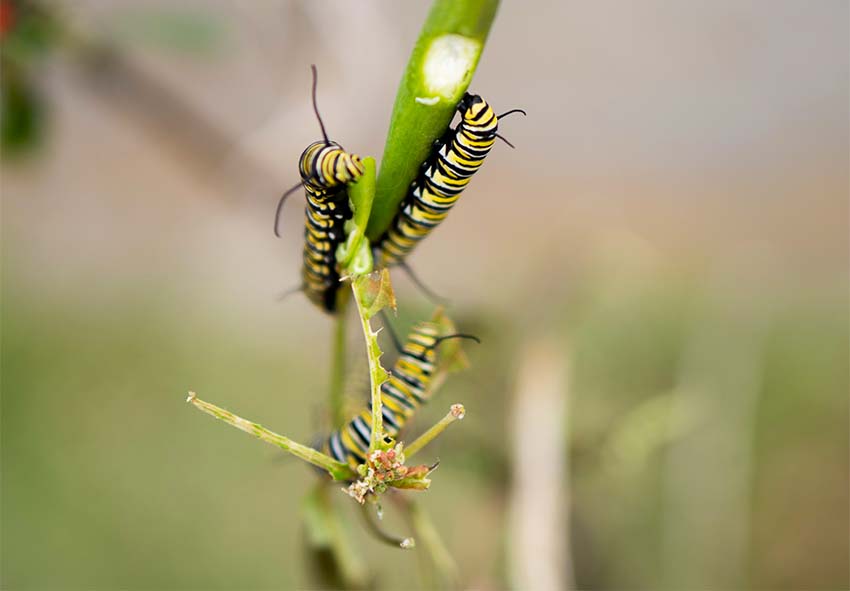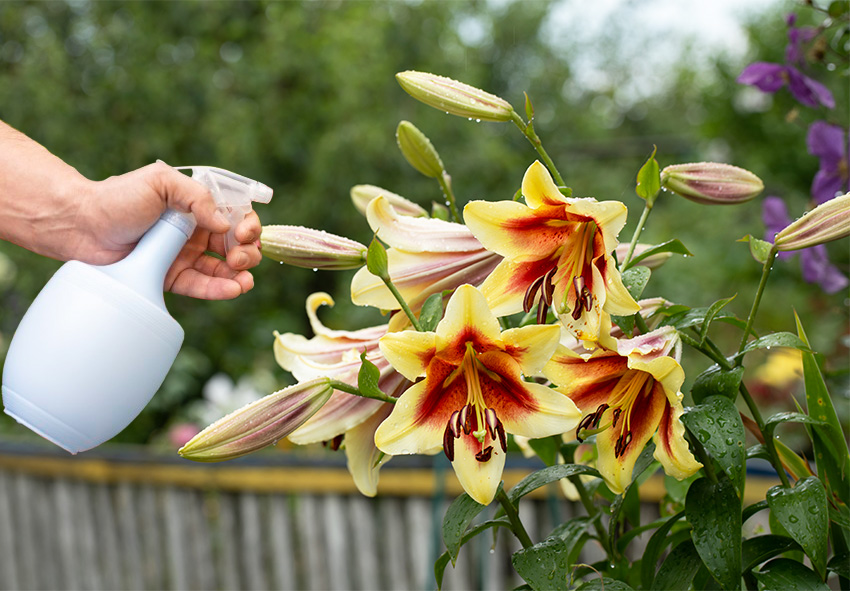Lilies are stunning, fragrant flowers that add elegance to any garden. However, these beautiful plants are often targeted by pests and diseases that can weaken or destroy them. Understanding how to protect your lilies from common problems is essential for maintaining their health and vibrancy. In this guide, we’ll cover the most frequent lily pests and diseases, along with prevention and treatment tips to keep your plants thriving. Our gardening blog is a perfect place to find all the information you need!
Common Pests That Affect Lilies

Lily plants are susceptible to several pests that can damage their leaves, stems, and flowers. Early detection and proper pest control measures can help protect your lilies and prevent infestations from spreading.
Lily Beetles (Red Lily Beetles)
Lily beetles are one of the most destructive pests for lilies. These bright red insects lay eggs on the undersides of leaves, and their larvae feed voraciously on the foliage. Signs of infestation include irregular holes in leaves and black, sticky larvae covering stems and leaves.
To control lily beetles, gardeners should manually remove them, encourage natural predators like birds and parasitic wasps, or use insecticidal soap and neem oil. Regular inspection of plants, especially during early spring when beetles emerge, can help catch infestations early. If the problem persists, consider rotating the planting area each season to reduce the beetle population.
Aphids
Aphids are tiny, sap-sucking insects that can cause significant damage to lilies. They weaken plants by extracting essential nutrients, leading to curling leaves and stunted growth. In addition, aphids can transmit plant viruses.
To prevent infestations, introduce beneficial insects like ladybugs, spray affected areas with a mixture of water and dish soap, or apply neem oil for effective organic pest control. Regularly inspect the undersides of leaves, where aphids tend to hide, to catch them before they cause extensive damage. Keeping plants healthy and stress-free can help them recover faster from aphid attacks.
Slugs and Snails
Slugs and snails thrive in damp environments and feed on young lily shoots and leaves. Their feeding results in large, irregular holes in foliage. To deter these pests, use crushed eggshells, diatomaceous earth, or copper tape around the base of your plants. If necessary, iron phosphate-based slug pellets provide an eco-friendly chemical solution.
Slugs and snails are most active during wet conditions, so monitoring your lilies after rain or in the morning can help identify their presence. Hand-picking these pests off plants and surrounding soil is another effective method for controlling them.
Thrips
Thrips are tiny, slender insects that suck the juices from lily petals and leaves, causing silvery streaks and deformed flowers. To control thrips, remove affected plant parts, introduce predatory insects like lacewings, and use insecticidal sprays when infestations are severe.
Thrips are often more active during warm weather, so check for them regularly, especially in the summer. Encouraging a diverse garden with various predatory insects can help manage thrips naturally without harming beneficial pollinators.
Common Diseases That Affect Lilies

Lilies can also suffer from fungal, bacterial, and viral infections. Proper care and preventative measures help minimize the risk of disease and ensure healthy, long-lasting blooms. Regular inspection of the plants is essential to detect any early signs of illness.
Botrytis Blight (Gray Mold)
Botrytis blight is a fungal disease that thrives in humid conditions. It appears as brown spots on leaves and flowers, eventually turning into a fuzzy gray mold.
To prevent this disease, ensure proper spacing between plants to improve airflow, water lilies at the base rather than overhead, and apply fungicides if needed. Regularly remove any infected plant parts to prevent the spread of the fungus. Pruning damaged areas can help improve the plant’s overall health and reduce stress.
Basal Rot
Basal rot is a soil-borne fungal disease that affects the bulbs of lilies, leading to yellowing leaves and rotting roots. It spreads in overly damp soil and can quickly kill infected plants.
Prevent basal rot by planting lilies in well-draining soil, avoiding excessive watering, and applying fungicide-treated bulbs before planting. If you notice symptoms of basal rot, remove and dispose of the affected plants to prevent contamination of surrounding soil. Also, ensure that the planting area has proper drainage to avoid waterlogging.
Mosaic Virus
Mosaic virus causes mottled, distorted leaves and stunted growth in lilies. It is primarily spread by aphids and infected gardening tools. Unfortunately, there is no cure for this virus, so prevention is crucial.
Remove and destroy infected plants, disinfect tools regularly, and control aphid populations to reduce the risk of transmission. Infected lilies should be removed immediately to prevent the spread of the virus to healthy plants. Keeping a close watch on your plants and maintaining healthy garden practices will help manage outbreaks.
Organic vs. Chemical Treatments
Both organic and chemical treatments play a role in controlling pests and diseases in lilies. While organic methods focus on natural solutions that are safer for the environment, chemical treatments provide stronger, targeted control for severe infestations. Below are some of the most effective options in both categories.
Organic Treatments
The following organic methods help protect lilies from pests and diseases without relying on synthetic chemicals:
- Neem Oil: A natural insecticide that disrupts the feeding and reproductive cycles of pests like aphids and thrips.
- Insecticidal Soap: A non-toxic solution that kills soft-bodied insects on contact without harming beneficial insects.
- Diatomaceous Earth: A fine powder that damages the exoskeletons of insects like slugs and beetles, leading to dehydration.
- Companion Planting: Growing plants like marigolds and lavender near lilies to naturally repel harmful insects.
Chemical Treatments

When infestations become severe, the following chemical treatments can provide effective control:
- Synthetic Insecticides: Products containing permethrin or imidacloprid that effectively kill stubborn pests but should be used cautiously.
- Fungicides: Copper-based and sulfur-based fungicides help prevent and treat fungal diseases like botrytis blight and basal rot.
- Systemic Pesticides: Absorbed by the plant to provide long-term protection against pests like lily beetles.
Best Practices for Lily Pest and Disease Prevention
Taking proactive steps to maintain lily health can prevent most pests and diseases from taking hold. By following best practices, gardeners can enjoy lush, vibrant blooms throughout the growing season. For more detailed tips and advice, check out our ultimate guide for lilies to ensure your garden thrives all year long.
Proper Planting Techniques
Start with healthy, disease-resistant lily varieties to reduce vulnerability to infections. Choose a well-draining planting site with good air circulation, as damp, stagnant environments encourage fungal growth. Mulching around the base of lilies helps retain moisture while keeping soil conditions balanced.
Regular Inspection and Maintenance
Routinely check your lilies for signs of pests or disease. Early detection allows for quick intervention, preventing problems from spreading. Remove damaged leaves, discard infected plants, and keep the garden clean by clearing away debris where pests might hide.
Seasonal Care Tips for Lilies
Different seasons require different care techniques to keep lilies healthy. In spring and summer, focus on watering, fertilization, and pest control. In fall, cut back dead foliage and remove any plant debris that may harbor diseases. For winter protection, mulch over bulbs to insulate them from freezing temperatures.
Conclusion
Protecting your lilies from pests and diseases requires a combination of vigilance, proper care, and preventative measures. By recognizing common problems early and applying effective solutions, you can keep your lilies healthy and thriving. Have you encountered pests or diseases in your lily garden? Share your experiences in the comments, and explore our store’s selection of pest control products to keep your lilies in top shape!
Frequently Asked Questions (FAQs) about Lily Pest and Diseases
1. How can I prevent diseases in my lilies?
To prevent diseases in lilies, ensure they are planted in well-draining soil, avoid overwatering, and space them properly for good air circulation. Regularly remove dead or infected plant material, and apply fungicides or insecticides as needed. Practicing good garden hygiene, like disinfecting tools, also helps prevent disease spread.
2. What are the signs of a lily beetle infestation?
Lily beetles leave irregular holes in leaves, and their larvae create a black, sticky mess on stems and leaves. You may also notice wilting or deformed flowers. Regularly inspect plants, especially in early spring, and manually remove beetles or apply neem oil to control infestations.
3. Can I order lilies from your online store?
Yes, you can! Our online store Dutch-bulbs.com offers a wide selection of lilies plants, including different varieties and colors. We take pride in providing top-quality plants that are carefully cultivated and shipped with care to ensure they reach you in perfect condition.
4. How do I treat aphid infestations on my lilies?
To treat aphids, spray affected lilies with a mixture of water and dish soap to remove the pests. You can also introduce natural predators like ladybugs or lacewings. Neem oil or insecticidal soap can be used for more severe infestations, but ensure to follow the label instructions for safe application.
5. Are there natural ways to control slugs and snails in my garden?
Yes, natural methods to control slugs and snails include using crushed eggshells, diatomaceous earth, or copper tape around plants. Encourage natural predators like frogs and birds, and remove slugs manually during the early morning or after rain.
Published: 04.02.2025
